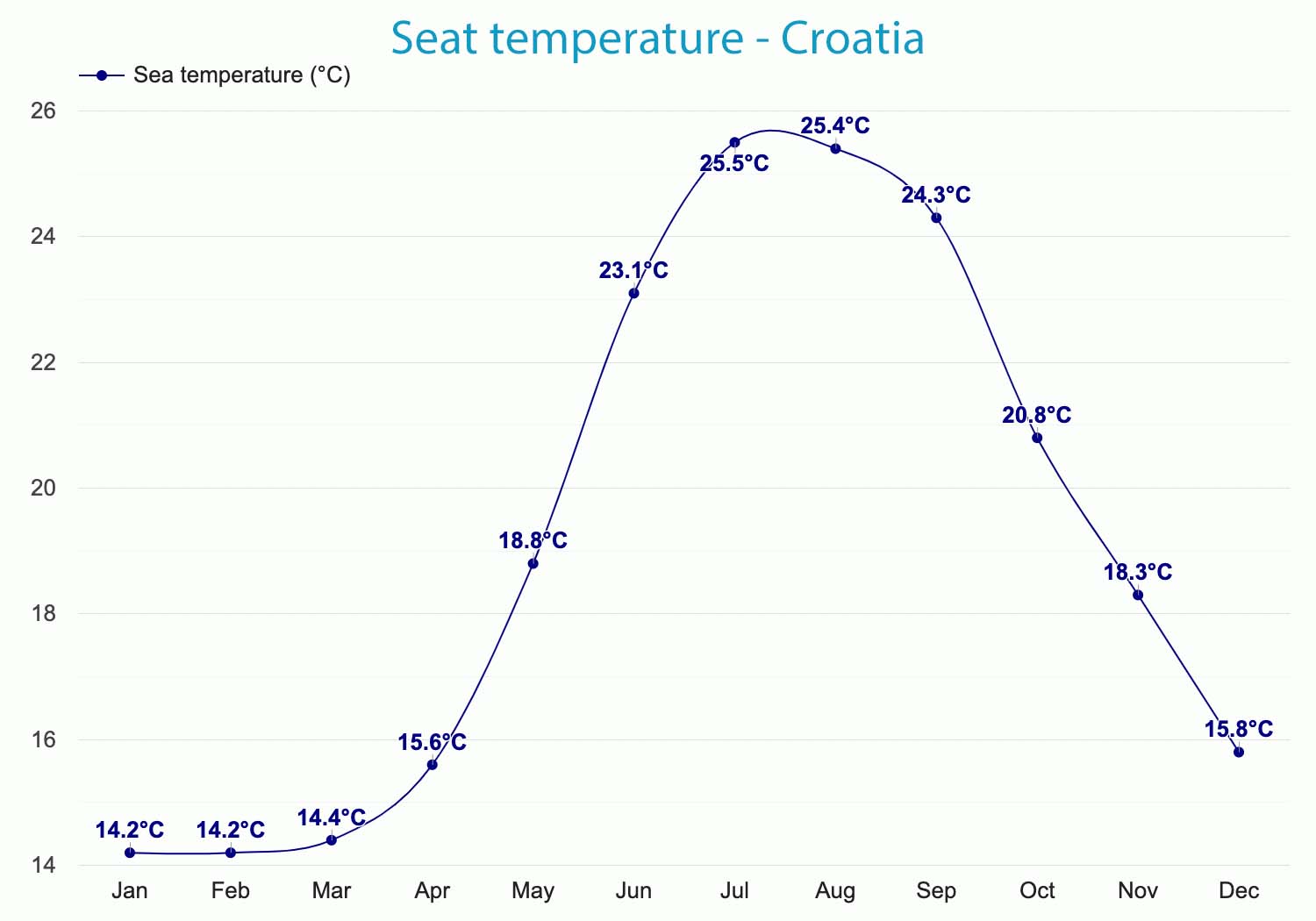Weather in Croatia
Check the online weather forecast in Croatia. Plan your trip on pour site with all the necessary information’s on one spot! Because we are here for you.
The climate of Croatia coast
Climate classification Csa by Köppen describes the humid subtropical and Mediterranean climate along the Croatian coast. Winters on the Croatian coast are somewhat chilly and damp, while summers are hot, muggy, and fairly dry. The Croatian coast is a popular tourist destination close to the Adriatic Sea’s southern shore. Although there are often chilly wind gusts from October to April, the temperature is generally pleasant. Average yearly precipitation is 1021.1mm (40.2″), with 109.2 rainy days. Thunderstorms often occur all year round. It doesn’t snow very often here.
During the summer, high temperatures often reach 27.8°C (82°F). August typically has its hottest days with a temperature of 25.8°C (78.4°F). In the winter, lows of 12.8°C (55°F) are common. January often has its lowest temperatures around 10°C (50°F).
The best time to visit Croatia coast
Croatia is a popular travel destination all year round due to its pleasant Mediterranean climate and 250 sunny days each year. The greatest months to visit Croatia’s coast are April through September, when the air is filled with the fragrant freshness of herbs, citrus fruits, and trees, and the sea beckons visitors for the summertime. During this time, a lovely sea wind often blows throughout the afternoon. In contrast to the air’s average temperature of 25.6°C (78.1°F) at this time, the sea’s average temperature of 21.1°C (70°F) provides a welcome change.
The worst time to visit Croatia coast
Although the winter months do not have very low temperatures, the months of November to February do experience cold temperatures along with gloomy skies and rain.
The wettest month is November, thus it is best to stay away from the Croatian shore at this time. Hotels offer indoor pools during the winter, but they can’t compare to being out in the open during bathing season. Intense gusty cold winds blow throughout the winter, which does not provide for pleasant weather.
Weather in January
Due to the dip in daytime temperatures from 6.6°C (43.9°F) to 12.3°C (54.1°F) at the beginning of the year, Croatia’s shore should be avoided.
Weather in February
Winter weather in February includes rain and freezing temperatures. The cold, which reaches 1.1°C (34°F) in the latter hours of the night, makes evenings uncomfortable.
Weather in March
In Croatia, springtime begins in March. During this time, the weather is often unsuitable for outdoor activities.
Weather in April
It’s the beginning of the vacation season in April, which is pleasant and humid with a little rise in air and water temperatures.
Weather in May
The weather is warm and May is an excellent month to visit the Croatian shore even if it has the greatest humidity of 67%.
Weather in June
The climate is generally dry and begins to warm up around June. The Croatian shore is beautiful in the summer and ideal for outdoor sports.
Weather in July
In Croatia, swimming is delightful due to a gentle afternoon wind and a moderate water temperature of 25.5°C (77.9°F).
Weather in August
Another excellent month to explore Croatia’s coast and islands is August, when the weather is dry and mild. With an average of only 5.1 wet days, the weather is excellent.
Weather in September
Autumn begins in September, which is an excellent season to explore Croatia’s coast and islands since the weather is mild and somewhat humid.
Weather in October
Croatia has moderate, rainy weather in October, with sporadic thunder and medium-sized showers. Rainfall of 119.4mm (4.7″) on average “) made October quite rainy.
Weather in November
Croatia’s wettest month is November, with 142.2mm (5.6″) “(inches) of rain. It is chilly and rainy outside, with brisk winds.
Weather in December
It is not advisable to go to the stunning Croatian coast and islands in December since it is chilly and wet.

FAQ
What time of year is the Croatian coast’s coldest?
January is the coldest month along the Croatian coast, with average high temperatures of 12.3°C (54.1°F) and low temperatures of 6.6°C (43.9°F).
How much rain falls along Croatia’s coast?
On Croatia’s coast, rain falls for 113.6 days out of the year, totaling 1063.9mm (41.9) “(precipitation) per hour.
When is Croatia’s sea the coldest?
With an average sea temperature of 14.2°C (57.6°F), January and February are the months in Croatia with the coldest saltwater. Swimming is unsafe when the temperature is 14.2°C (57.6°F). Unprotected immersion at temperatures below 10°C (50°F) immediately results in a cold shock with a maximal severity and hyperventilation.
What time of year is the Croatian shore the driest?
The month with the least precipitation is July, when it normally rains for 4.7 days and yields 28.3mm (1.1″) “(precipitation) per hour.
In which month is Croatia’s sea the warmest?
With an average sea temperature of 25.5°C (77.9°F), July is the month with the hottest sea temperatures in Croatia. Everyone enjoys swimming in water that is between 25°C (77°F) and 29°C (84.2°F), which is considered to be quite warm. Activities involving the water are enjoyable at these temperatures without becoming unpleasant for extended periods of time.
On Croatia’s shore, which month is the warmest?
August is the hottest month in Croatia, with an average high temperature of 28.5 °C (83.3 °F) and an average low temperature of 21.6 °C (70.9 °F).
Which month has the wettest weather along Croatia’s coast?
The month with the greatest rainfall in D is November.






